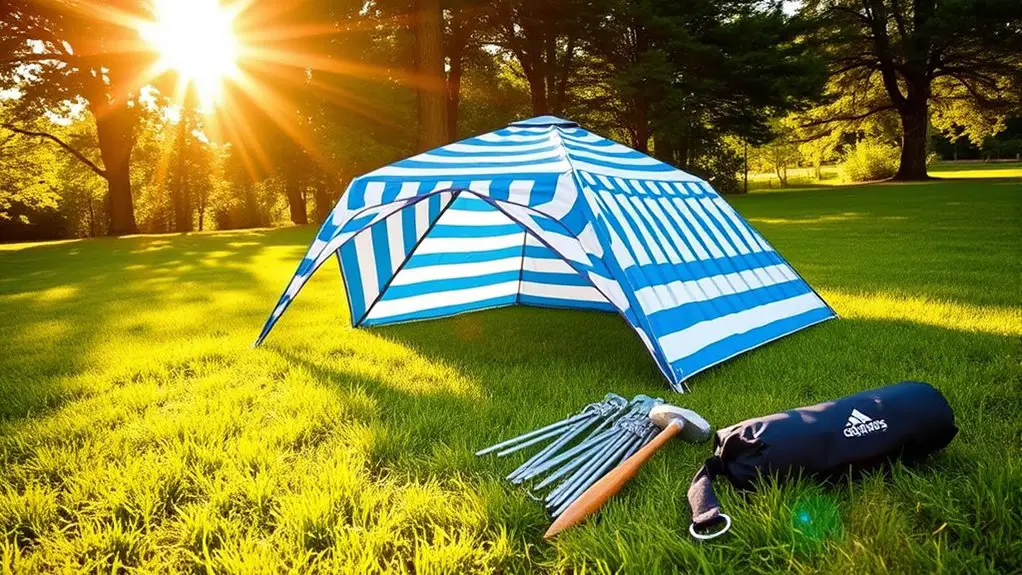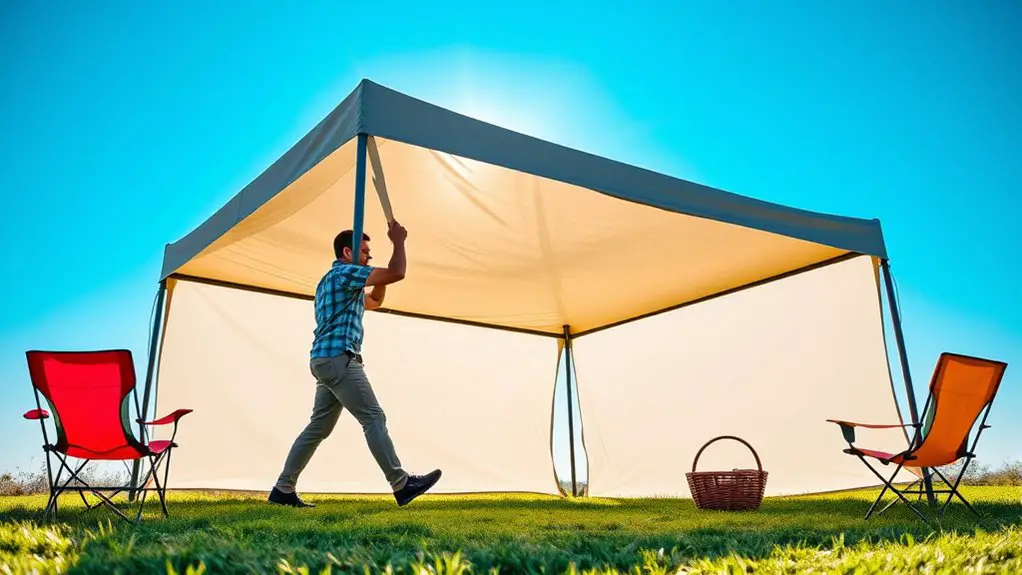To set up a portable gazebo in 10 minutes, start by choosing a level spot and gathering all your materials. Unpack the gazebo and organize the components. Assemble the frame by connecting the poles and securing the legs. Once the frame is up, attach the canopy using hooks or ties. Secure the structure with stakes and weights if needed. Finally, check for stability and adjust for evenness. There’s more to enhancing your gazebo experience, so keep going!
Gather Your Materials

Before you start setting up your portable gazebo, it’s essential to gather all the necessary materials. First, check the material types of your gazebo, which may include fabric, metal, or plastic components. Confirm you have the framework, canopy, and any additional parts like stakes or ropes.
Next, consider storage solutions for these materials. A dedicated storage bag can keep everything organized and protected from the elements when not in use. If you don’t have a bag, use bins or containers to separate pieces, making it easier to find what you need at setup time.
Don’t forget tools like a mallet or screwdriver, if required. Having all your materials at hand will streamline the process and let you enjoy your gazebo’s freedom without unnecessary delays. By being prepared, you can quickly create your outdoor oasis for relaxation and enjoyment. Additionally, ensure that you are familiar with the setup and maintenance of folding gazebo tents as this will help you avoid common pitfalls during assembly.
Choose the Right Location
Choosing the right location for your portable gazebo is essential for maximizing its usefulness and comfort. When picking a spot, keep these location considerations in mind:
Selecting the ideal location for your portable gazebo is crucial for enhancing comfort and functionality.
- Ground Conditions: Make certain the ground is level and stable. Avoid areas with loose soil or excessive debris to provide a solid foundation.
- Sun Exposure: Pick a location that offers shade during peak sun hours. This will keep the temperature comfortable and protect you from UV rays.
- Wind Protection: Consider natural barriers like trees or fences to shield your gazebo from strong winds, making sure it stays anchored and secure. Additionally, take into account the orientation of the backyard to optimize sun and wind exposure for your gazebo.
Unpack the Gazebo

Before you start setting up your portable gazebo, make certain you’ve gathered all necessary tools, like a hammer and stakes. Carefully remove the gazebo from its packaging, checking for any missing parts or damage. This will guarantee you’re ready to assemble it without any interruptions. Additionally, make sure to inspect for damage to ensure all components are in good condition.
Gather Necessary Tools
Once you’ve selected the perfect spot for your portable gazebo, it’s essential to gather all the necessary tools to guarantee a smooth setup process. A solid tools checklist will keep you organized and confirm you have the essential equipment ready. Here’s what you need:
- Hammer or Mallet – For securing stakes into the ground.
- Rope or Tie Downs – To stabilize your gazebo against wind.
- Measuring Tape – To confirm proper placement and spacing.
With these items in hand, you’ll be well-prepared to tackle the setup efficiently. Being ready not only saves time but also enhances your outdoor experience, allowing you to enjoy the freedom of your space without any hiccups.
Remove From Packaging
After confirming you have a clear area to work, it’s time to unpack your portable gazebo. Start by carefully removing the packaging types, which may include plastic wrap, cardboard, or straps. Be mindful not to damage the gazebo materials inside as you cut through any bindings. Once the gazebo is free, lay out all components, including the frame, canopy, and any stakes or ropes. Check the instructions to confirm you have everything needed for setup. If you notice any missing parts or damage, address it before proceeding. A quick organization of these materials will streamline the assembly process, giving you the freedom to enjoy your outdoor space without delay. Now you’re ready for the next step!
Assemble the Frame
Now that you’ve unpacked the gazebo, it’s time to assemble the frame. Start by organizing all the components and connecting the frame poles securely. Don’t forget to guarantee stability by using anchors, especially if it’s windy. Proper anchoring is crucial to prevent wind-related damage, so make sure to secure the gazebo effectively.
Unpack and Organize Components
To successfully assemble your portable gazebo, start by unpacking and organizing all components. Proper component identification is key to a smooth setup. Here are some organization tips to help you get started:
- Lay Out the Poles: Arrange the frame poles in order of size, so you can easily grab the right one when needed.
- Group Accessories: Keep stakes, connectors, and fabric covers in separate piles to avoid confusion.
- Check for Completeness: Before you start, double-check that you have all parts listed in the instruction manual.
Connect Frame Poles Securely
Connecting the frame poles securely is vital for the stability of your portable gazebo. Start by laying out all the poles and identifying each segment. Use effective frame connection techniques, like sliding the poles into each other until they click into place. For a tight fit, make certain to align the poles correctly; follow pole alignment tips by confirming that each pole is straight and locked before proceeding. This prevents wobbling and guarantees your gazebo stands strong. As you work, be mindful of the order in which you connect the poles; it can save you time and effort. Once everything’s secure, you’re one step closer to enjoying your outdoor space without worry.
Ensure Stability With Anchors
Four key anchors can make all the difference in ensuring your portable gazebo remains stable, especially on windy days. Depending on your weather conditions, choosing the right anchor types is essential. Here’s a quick list to guide you:
- Sandbags: Easy to transport and effective, they weigh down the legs without damaging surfaces.
- Stake Anchors: Ideal for soft ground, these go deep into the earth, providing strong resistance against gusts.
- Weighted Plates: Perfect for hard surfaces, these plates can be secured on the legs, offering reliable stability.
Attach the Canopy
Attaching the canopy is an essential step in setting up your portable gazebo. First, lay out your canopy materials, ensuring you’ve got the right size and style for your gazebo frame. Different canopy styles, like pop-up or dome, may require specific attachment methods, so check your manufacturer’s instructions.
Once you’ve identified the correct canopy, align it with the frame. Most canopies come with hooks, Velcro, or ties to secure them in place. If you’re using a hook system, make sure each corner is attached firmly to prevent sagging or flapping in the wind.
Take a moment to smooth out any wrinkles for a neat appearance. This not only enhances the look but also helps with stability. After you’ve secured the canopy, step back and admire your work. With the canopy in place, you’re one step closer to enjoying your outdoor space. Remember, selecting a canopy made from water-resistant materials can significantly enhance your gazebo’s durability in varying weather conditions.
Secure the Structure

Once the canopy is securely in place, it’s essential to guarantee the gazebo structure is stable. This step is vital for ensuring wind resistance and maintaining structural integrity. Here’s how to secure your portable gazebo effectively:
- Stake Down the Corners: Use ground stakes to anchor each corner of the gazebo. This helps resist strong winds and keeps the structure grounded.
- Add Weight Bags: If you’re on a hard surface, consider using weight bags. Fill them with sand or gravel and place them on each leg of the gazebo to enhance stability.
- Check for Leveling: Make sure your gazebo is level. Use a bubble level to adjust the legs as needed so that it stands evenly, reducing the risk of tipping. Additionally, using metal stakes or auger-style anchors will further enhance the gazebo’s stability in windy conditions.
Enjoy Your New Shelter
With your portable gazebo securely anchored and stable, it’s time to enjoy your new shelter. This versatile space opens up countless opportunities for outdoor activities. Whether it’s a sunny day or a light drizzle, your gazebo provides the perfect refuge to relax and unwind.
Set up your favorite outdoor furniture and create a cozy atmosphere for family gatherings. You can host barbecues, birthday parties, or just a casual get-together with friends. The added shade and shelter invite you to enjoy meals outdoors without worrying about the weather. Additionally, a gazebo can increase property value and enhance the overall appeal of your outdoor space.
Don’t forget to add personal touches, like string lights or decorations, to make it feel like home. Embrace the freedom your gazebo offers by spending quality time with loved ones in a comfortable, inviting space. With just a few simple adjustments, you’ll transform your backyard into an enjoyable haven for everyone. So, gather your family and plunge into your next adventure!
Frequently Asked Questions
How Many People Are Needed to Set up the Gazebo?
You’ll need at least two people for effective setup assistance. With team coordination, the process becomes smoother, allowing you to enjoy your time outdoors without the hassle of struggling alone with the gazebo.
Can I Set up the Gazebo on Uneven Ground?
You can set up a gazebo on uneven ground, but consider uneven terrain challenges. Use stability tips like leveling the base and securing with stakes to guarantee your gazebo remains steady and functional throughout your event.
What Is the Best Way to Clean the Gazebo Fabric?
To clean your gazebo fabric, use gentle cleaning solutions like mild soap mixed with water. Avoid harsh chemicals, and always check fabric care labels. Rinse thoroughly and let it dry completely for ideal maintenance and longevity.
How Do I Store the Gazebo When Not in Use?
When the sun sets on your gazebo adventures, fold it neatly and store it in a cool, dry place. Use storage solutions like breathable bags, and keep maintenance tips in mind for longevity and ease.
Is the Gazebo Waterproof or Water-Resistant?
Your gazebo’s waterproof materials can handle light rain, but it’s best to check your model’s specifications. In severe weather conditions, consider taking it down to guarantee longevity and maintain its integrity. Enjoy your outdoor freedom!

